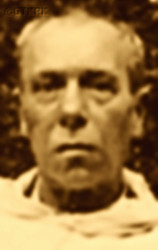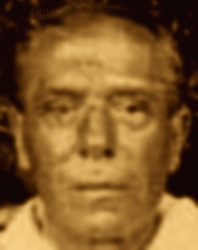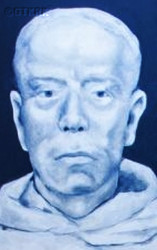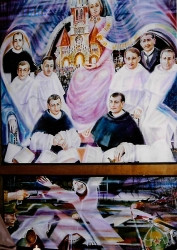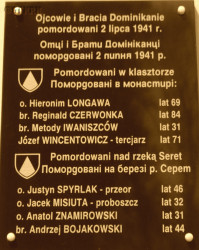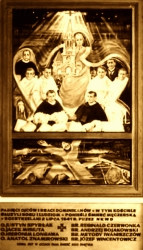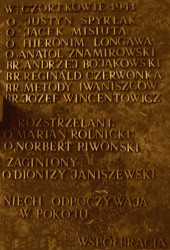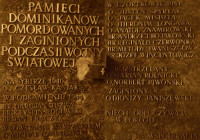Roman Catholic
St Sigismund parish
05-507 Słomczyn
85 Wiślana Str.
Konstancin deanery
Warsaw archdiocese, Poland
full list:
displayClick to display full list

searchClick to search full list by categories
wyświetlKliknij by wyświetlić pełną listę po polsku

szukajKliknij by przeszukać listę wg kategorii po polsku

Martyrology of the clergy — Poland
XX century (1914 – 1989)
personal data
religious status
Servant of God
surname
LONGAWA
forename(s)
Francis (pl. Franciszek)
religious forename(s)
Jerome (pl. Hieronim)
function
religious cleric
creed
Latin (Roman Catholic) Church RCmore on
en.wikipedia.org
[access: 2014.09.21]
congregation
Order of Preachers OPmore on
en.wikipedia.org
[access: 2013.07.06]
(i.e. Dominican Order, Dominicans)
diocese / province
St Hyacinth Polish Province
St Hyacinth Galicia Province OP
Lviv archdiocesemore on
en.wikipedia.org
[access: 2013.05.19]
date and place
of death
02.07.1941

Chortkivtoday: Chortkiv urban hrom., Chortkiv rai., Ternopil obl., Ukraine
more on
en.wikipedia.org
[access: 2020.11.20]
details of death
During Polish–Ukrainian war of 1918‐1919 interned for a short time by the Ukrainians.
After German and Russian invasion of Poland in 09.1939 and start of the World War II, after German attack in 06.1941 of their erstwhile ally, Russians, during panic retreat of Russians before advancing Germans — apprehended in the monastery (church's sacristy was vandalized) and murdered by the local Jews helping the genocidal Russian organization NKVD with a shot to the back of the head.
Three other co–friars were murdered in the monastery, four other were brought to the banks of a local Seret river and murdered there.
cause of death
mass murder
perpetrators
Russians / Jews
sites and events
ChortkivClick to display the description, 06.1941 massacres (NKVD)Click to display the description, Ribbentrop‐MolotovClick to display the description, Pius XI's encyclicalsClick to display the description, Polish‐Ukrainian war of 1918‐1919Click to display the description
date and place
of birth
06.10.1872Birth certification on:
photos.szukajwarchiwach.gov.pl
[access: 2025.04.19]

Niżna Łąkatoday: Miejsce Piastowe gm., Krosno pov., Subcarpathia voiv., Poland
more on
en.wikipedia.org
[access: 2021.12.18]
parents
LONGAWA Paul
🞲 ?, ? — 🕆 ?, ?

DOBRUCKA Caroline
🞲 ?, ? — 🕆 ?, ?
baptism
07.10.1872Birth certification on:
photos.szukajwarchiwach.gov.pl
[access: 2025.04.19]

Bóbrkatoday: Chorkówka gm., Krosno pov., Subcarpathia voiv., Poland
more on
en.wikipedia.org
[access: 2025.04.19]
St Catherine the Virgin and Martyr RC church
religious vows
05.10.1895 (temporary)
14.12.1900 (permanent)
presbyter (holy orders)
ordination
07.07.1901

positions held
1937 – 1941
friar — Chortkivtoday: Chortkiv urban hrom., Chortkiv rai., Ternopil obl., Ukraine
more on
en.wikipedia.org
[access: 2020.11.20] ⋄ St Stanislav the Bishop and Martyr monastery, Dominicans OP — also. trustee, i.e. administrator of monastery estate
1935 – 1937
monastery friar and parish vicar — Pidkamintoday: Pidkamin hrom., Zolochiv rai., Lviv obl., Ukraine
more on
en.wikipedia.org
[access: 2021.02.12] ⋄ Blessed Virgin Mary of the Rosary monastery, Dominicans OP ⋄ Assumption of the Blessed Virgin Mary RC parish ⋄ Brodytoday: Brody urban hrom., Zolochiv rai., Lviv obl., Ukraine
more on
en.wikipedia.org
[access: 2020.11.20] RC deanery
1933 – 1935
monastery friar and parish administrator — Lvivtoday: Lviv urban hrom., Lviv rai., Lviv obl., Ukraine
more on
en.wikipedia.org
[access: 2022.01.16] ⋄ Corpus Christi monastery, Dominicans OP ⋄ Kosteivtoday: Kulykiv hrom., Lviv rai., Lviv obl., Ukraine
more on
uk.wikipedia.org
[access: 2022.11.20], St Nicholas the Bishop and Confessor RC parish ⋄ Kosteivtoday: Kulykiv hrom., Lviv rai., Lviv obl., Ukraine
more on
uk.wikipedia.org
[access: 2022.11.20], St Nicholas the Bishop and Confessor RC parish ⋄ Lviv intra Urbemdeanery name
today: Lviv obl., Ukraine RC deanery
1932 – 1933
friar — Pidkamintoday: Pidkamin hrom., Zolochiv rai., Lviv obl., Ukraine
more on
en.wikipedia.org
[access: 2021.02.12] ⋄ Blessed Virgin Mary of the Rosary monastery, Dominicans OP
c. 1922 – 1932
monastery prior and parish administrator — Zolotyi Potiktoday: Zolotyi Potik hrom., Chortkiv rai., Ternopil obl., Ukraine
more on
en.wikipedia.org
[access: 2021.12.19] ⋄ St Stephen the Protomartyr monastery, Dominicans OP ⋄ Nativity of the Blessed Virgin Mary and St Stephen RC parish ⋄ Buchachtoday: Buchach urban hrom., Chortkiv rai., Ternopil obl., Ukraine
more on
en.wikipedia.org
[access: 2020.11.15] RC deanery — also: chaplain of the Third Order of Saint Dominic TOP
1920 – c. 1921
monastery prior and parish administrator — Yezupiltoday: Yezupil hrom., Stanislaviv/Ivano‐Frankivsk rai., Stanislaviv/Ivano‐Frankivsk obl., Ukraine
more on
en.wikipedia.org
[access: 2022.11.20] ⋄ Assumption of the Blessed Virgin Mary monastery, Dominicans OP ⋄ Assumption of the Blessed Virgin Mary RC parish ⋄ Stanislavivtoday: Ivano‐Frankivsk, Stanislaviv/Ivano‐Frankivsk rai., Stanislaviv/Ivano‐Frankivsk obl., Ukraine
more on
en.wikipedia.org
[access: 2020.11.20] RC deanery
1919 – 1920
friar — Zhovkvatoday: Zhovkva urban hrom., Lviv rai., Lviv obl., Ukraine
more on
en.wikipedia.org
[access: 2020.11.22] ⋄ Assumption of the Blessed Virgin Mary monastery, Dominicans OP
1919
friar — Ternopiltoday: Ternopil urban hrom., Ternopil rai., Ternopil obl., Ukraine
more on
en.wikipedia.org
[access: 2020.11.20] ⋄ St Vincent Ferrer monastery, Dominicans OP
1916 – 1919
prior — Zhovkvatoday: Zhovkva urban hrom., Lviv rai., Lviv obl., Ukraine
more on
en.wikipedia.org
[access: 2020.11.22] ⋄ Assumption of the Blessed Virgin Mary monastery, Dominicans OP
1911 – 1916
deputy prior — Zhovkvatoday: Zhovkva urban hrom., Lviv rai., Lviv obl., Ukraine
more on
en.wikipedia.org
[access: 2020.11.22] ⋄ Assumption of the Blessed Virgin Mary monastery, Dominicans OP — also. trustee, i.e. administrator of monastery estate
1908 – 1911
monastery friar and parish administrator — Zolotyi Potiktoday: Zolotyi Potik hrom., Chortkiv rai., Ternopil obl., Ukraine
more on
en.wikipedia.org
[access: 2021.12.19] ⋄ St Stephen the Protomartyr monastery, Dominicans OP ⋄ Nativity of the Blessed Virgin Mary and St Stephen RC parish ⋄ Buchachtoday: Buchach urban hrom., Chortkiv rai., Ternopil obl., Ukraine
more on
en.wikipedia.org
[access: 2020.11.15] RC deanery
1906 – 1908
monastery friar and parish vicar — Tysmenytsyatoday: Tysmenytsya urban hrom., Stanislaviv/Ivano‐Frankivsk rai., Stanislaviv/Ivano‐Frankivsk obl., Ukraine
more on
en.wikipedia.org
[access: 2020.11.27] ⋄ St Nicholas the Bishop and Confessor monastery, Dominicans OP ⋄ St Nicholas the Bishop and Confessor RC parish ⋄ Stanislavivtoday: Ivano‐Frankivsk, Stanislaviv/Ivano‐Frankivsk rai., Stanislaviv/Ivano‐Frankivsk obl., Ukraine
more on
en.wikipedia.org
[access: 2020.11.20] RC deanery
c. 1906
monastery friar and parish vicar — Chortkivtoday: Chortkiv urban hrom., Chortkiv rai., Ternopil obl., Ukraine
more on
en.wikipedia.org
[access: 2020.11.20] ⋄ St Stanislav the Bishop and Martyr monastery, Dominicans OP ⋄ St Stanislav the Bishop and Martyr RC parish ⋄ Chortkivtoday: Chortkiv urban hrom., Chortkiv rai., Ternopil obl., Ukraine
more on
en.wikipedia.org
[access: 2020.11.20] RC deanery
1904 – 1905
monastery friar and parish vicar — Bohorodchanytoday: Bohorodchany hrom., Stanislaviv/Ivano‐Frankivsk rai., Stanislaviv/Ivano‐Frankivsk obl., Ukraine
more on
en.wikipedia.org
[access: 2022.08.05] ⋄ Visitation of the Blessed Virgin Mary monastery, Dominicans OP ⋄ Visitation of the Blessed Virgin Mary RC parish ⋄ Stanislavivtoday: Ivano‐Frankivsk, Stanislaviv/Ivano‐Frankivsk rai., Stanislaviv/Ivano‐Frankivsk obl., Ukraine
more on
en.wikipedia.org
[access: 2020.11.20] RC deanery — also: catechist
1902 – 1904
monastery friar and parish vicar — Pidkamintoday: Pidkamin hrom., Zolochiv rai., Lviv obl., Ukraine
more on
en.wikipedia.org
[access: 2021.02.12] ⋄ Blessed Virgin Mary of the Rosary monastery, Dominicans OP ⋄ Assumption of the Blessed Virgin Mary RC parish ⋄ Brodytoday: Brody urban hrom., Zolochiv rai., Lviv obl., Ukraine
more on
en.wikipedia.org
[access: 2020.11.20] RC deanery — also. trustee, i.e. administrator of monastery estate
1901 – 1902
friar — Lvivtoday: Lviv urban hrom., Lviv rai., Lviv obl., Ukraine
more on
en.wikipedia.org
[access: 2022.01.16] ⋄ Corpus Christi monastery, Dominicans OP — monastery treasury officer / procurator and member of the monastery chapter/council
1901
monastery friar and parish vicar — Pidkamintoday: Pidkamin hrom., Zolochiv rai., Lviv obl., Ukraine
more on
en.wikipedia.org
[access: 2021.02.12] ⋄ Blessed Virgin Mary of the Rosary monastery, Dominicans OP ⋄ Assumption of the Blessed Virgin Mary RC parish ⋄ Brodytoday: Brody urban hrom., Zolochiv rai., Lviv obl., Ukraine
more on
en.wikipedia.org
[access: 2020.11.20] RC deanery
1895 – 1901
student — Lvivtoday: Lviv urban hrom., Lviv rai., Lviv obl., Ukraine
more on
en.wikipedia.org
[access: 2022.01.16] ⋄ Philosophical and Theological Studies, Corpus Christi monastery, Dominicans OP
30.09.1894 – 05.10.1895
novitiate — Krakówtoday: Kraków city pov., Lesser Poland voiv., Poland
more on
en.wikipedia.org
[access: 2021.06.07] ⋄ Holy Trinity monastery, Dominicans OP
07.09.1894
accession — Krakówtoday: Kraków city pov., Lesser Poland voiv., Poland
more on
en.wikipedia.org
[access: 2021.06.07] ⋄ Holy Trinity monastery, Dominicans OP
others related
in death
BOJAKOWSKIClick to display biography Stanislav (Bro. Andrew Mary), CZERWONKAClick to display biography Martin (Bro. Reginald), IWANISZCZÓWClick to display biography Charles (Bro. Methodius), MISIUTAClick to display biography Stanislav (Fr Hyacinth), SPYRŁAKClick to display biography John (Fr Justin), WINCENTOWICZClick to display biography Joseph, ZNAMIROWSKIClick to display biography Adam (Fr Anatol Mary)
sites and events
descriptions
Chortkiv: When the news of German attack reach Chortkiv Russians murdered approx. 200 prisoners in local jail (some where walled over, the other massacred on the prison yard). The rest were driven to Humań, where approx. 700 of them were massacred. 350 more died deported to Russia. On 02.07.1941 Russians entered the Dominican convent in Chortkiv and murdered, with the help of local Jews, all religious (four were murdered within the walls of the monastery, four others were marched out to the banks of Seret river and there executed with a shot to the head). Next they defiled the church and burnt the monastery. Chortkiv remembered then — now totally forgotten — an attempt on 20.01.1940 by mainly Polish gymnasium students to free Polish prisoners from local jail, taking over the train station and driving a train to a nearby Romania. The attempt failed, 3 Russians died. In reprisal Russians arrested 128 people, murdered 35 and the rest exiled to Siberia. (more on: www.blogpress.plClick to attempt to display webpage
[access: 2013.08.31], www.fronda.plClick to attempt to display webpage
[access: 2014.05.09])
06.1941 massacres (NKVD): After German attack of Russian‐occupied Polish territory and following that of Russia itself, before a panic escape, Russians murdered — in accordance with the genocidal order issued on 24.06.1941 by the Russian interior minister Lawrence Beria to murder all prisoners (formally „sentenced” for „counter‐revolutionary activities”, „anti‐Russian acts”, sabotage and diversion, and political prisoners „in custody”), held in NKVD‐run prisons in Russian occupied Poland, Lithuania, Latvia and Estonia — c. 40,000‐50,000 prisoners. In addition Russians murdered many thousands of victims arrested after German attack regarding them as „enemies of people” — those victims were not even entered into prisons’ registers. Most of them were murdered in massacres in the prisons themselves, the others during so‐called „death marches” when the prisoners were driven out east. After Russians departure and start of German occupation a number of spontaneous pogroms of Jews took place. Many Jews collaborated with Russians and were regarded as co‐responsible for prison massacres. (more on: en.wikipedia.orgClick to attempt to display webpage
[access: 2021.12.19])
Ribbentrop‐Molotov: Genocidal Russian‐German alliance pact between Russian leader Joseph Stalin and German leader Adolf Hitler signed on 23.08.1939 in Moscow by respective foreign ministers, Mr. Vyacheslav Molotov for Russia and Joachim von Ribbentrop for Germany. The pact sanctioned and was the direct cause of joint Russian and German invasion of Poland and the outbreak of the World War II in 09.1939. In a political sense, the pact was an attempt to restore the status quo ante before 1914, with one exception, namely the „commercial” exchange of the so‐called „Kingdom of Poland”, which in 1914 was part of the Russian Empire, fore Eastern Galicia (today's western Ukraine), in 1914 belonging to the Austro‐Hungarian Empire. Galicia, including Lviv, was to be taken over by the Russians, the „Kingdom of Poland” — under the name of the General Governorate — Germany. The resultant „war was one of the greatest calamities and dramas of humanity in history, for two atheistic and anti‐Christian ideologies — national and international socialism — rejected God and His fifth Decalogue commandment: Thou shall not kill!” (Abp Stanislav Gądecki, 01.09.2019). The decisions taken — backed up by the betrayal of the formal allies of Poland, France and Germany, which on 12.09.1939, at a joint conference in Abbeville, decided not to provide aid to attacked Poland and not to take military action against Germany (a clear breach of treaty obligations with Poland) — were on 28.09.1939 slightly altered and made more precise when a treaty on „German‐Russian boundaries and friendship” was agreed by the same murderous signatories. One of its findings was establishment of spheres of influence in Central and Eastern Europe and in consequence IV partition of Poland. In one of its secret annexes agreed, that: „the Signatories will not tolerate on its respective territories any Polish propaganda that affects the territory of the other Side. On their respective territories they will suppress all such propaganda and inform each other of the measures taken to accomplish it”. The agreements resulted in a series of meeting between two genocidal organization representing both sides — German Gestapo and Russian NKVD when coordination of efforts to exterminate Polish intelligentsia and Polish leading classes (in Germany called «Intelligenzaktion», in Russia took the form of Katyń massacres) where discussed. Resulted in deaths of hundreds of thousands of Polish intelligentsia, including thousands of priests presented here, and tens of millions of ordinary people,. The results of this Russian‐German pact lasted till 1989 and are still in evidence even today. (more on: en.wikipedia.orgClick to attempt to display webpage
[access: 2015.09.30])
Pius XI's encyclicals: Facing the creation of two totalitarian systems in Europe, which seemed to compete with each other, though there were more similarities than contradictions between them, Pope Pius XI issued in 03.1937 (within 5 days) two encyclicals. In the „Mit brennender Sorge” (Eng. „With Burning Concern”) published on 14.03.1938, condemned the national socialism prevailing in Germany. The Pope wrote: „Whoever, following the old Germanic‐pre‐Christian beliefs, puts various impersonal fate in the place of a personal God, denies the wisdom of God and Providence […], whoever exalts earthly values: race or nation, or state, or state system, representatives of state power or other fundamental values of human society, […] and makes them the highest standard of all values, including religious ones, and idolizes them, this one […] is far from true faith in God and from a worldview corresponding to such faith”. On 19.03.1937, published „Divini Redemptoris” (Eng. „Divine Redeemer”), in which criticized Russian communism, dialectical materialism and the class struggle theory. The Pope wrote: „Communism deprives man of freedom, and therefore the spiritual basis of all life norms. It deprives the human person of all his dignity and any moral support with which he could resist the onslaught of blind passions […] This is the new gospel that Bolshevik and godless communism preaches as a message of salvation and redemption of humanity”… Pius XI demanded that the established human law be subjected to the natural law of God , recommended the implementation of the ideal of a Christian state and society, and called on Catholics to resist. Two years later, National Socialist Germany and Communist Russia came together and started World War II. (more on: www.vatican.vaClick to attempt to display webpage
[access: 2023.05.28], www.vatican.vaClick to attempt to display webpage
[access: 2023.05.28])
Polish‐Ukrainian war of 1918‐1919: One of the wars for borders of the newly reborn Poland. At the end of 1918 on the former Austro‐Hungarian empire’s territory, based on the Ukrainian military units of the former Austro‐Hungarian army, Ukrainians waged war against Poland. In particular attempted to create foundation of an independent state and attacked Lviv. Thanks to heroic stance of Lviv inhabitants, in particular young generation of Poles — called since then Lviv eaglets — the city was recaptured by Poles and for a number of months successfully defended against furious Ukrainian attacks. In 1919 Poland — its newly created army — pushed Ukrainian forces far to the east and south, regaining control over its territory. (more on: en.wikipedia.orgClick to attempt to display webpage
[access: 2017.05.20])
sources
personal:
www.jerzyrobertnowak.comClick to attempt to display webpage
[access: 2013.01.06], www.zulice31.parafia.info.plClick to attempt to display webpage
[access: 2013.01.06], photos.szukajwarchiwach.gov.plClick to attempt to display webpage
[access: 2025.04.19], cracovia-leopolis.plClick to attempt to display webpage
[access: 2013.01.06]
bibliographical:
„Register of Latin rite Lviv metropolis clergy’s losses in 1939‐45”, Józef Krętosz, Maria Pawłowiczowa, editors, Opole, 2005
„Biographical lexicon of Lviv Roman Catholic Metropoly clergy victims of the II World War 1939‐1945”, Mary Pawłowiczowa (ed.), Fr Joseph Krętosz (ed.), Holy Cross Publishing, Opole, 2007
„Mysterium iniquitatis. Clergy and religious of the Latin rite murdered by Ukrainian nationalists in 1939‐1945”, Fr Józef Marecki, Institute of National Remembrance IPN, Kraków 2020
original images:
atlaswsi.plClick to attempt to display webpage
[access: 2015.04.18], bobrka.przemyska.plClick to attempt to display webpage
[access: 2018.09.02], www.myheritage.plClick to attempt to display webpage
[access: 2017.03.11], bobrka.przemyska.plClick to attempt to display webpage
[access: 2017.11.07], bobrka.przemyska.plClick to attempt to display webpage
[access: 2018.09.02], nieobecni.com.plClick to attempt to display webpage
[access: 2015.04.18], mbc.malopolska.plClick to attempt to display webpage
[access: 2016.03.14], ipn.gov.plClick to attempt to display webpage
[access: 2019.02.02]
LETTER to CUSTODIAN/ADMINISTRATOR
If you have an Email client on your communicator/computer — such as Mozilla Thunderbird, Windows Mail or Microsoft Outlook, described at WikipediaPatrz:
en.wikipedia.org, among others — try the link below, please:
LETTER to CUSTODIAN/ADMINISTRATORClick and try to call your own Email client
If however you do not run such a client or the above link is not active please send an email to the Custodian/Administrator using your account — in your customary email/correspondence engine — at the following address:

giving the following as the subject:
MARTYROLOGY: LONGAWA Francis
To return to the biography press below:
 Click to return to biography
Click to return to biography









